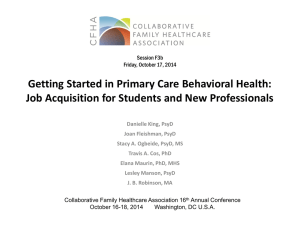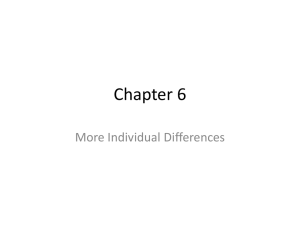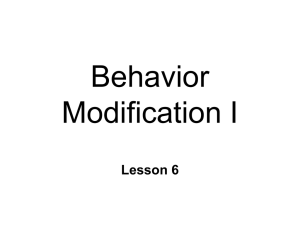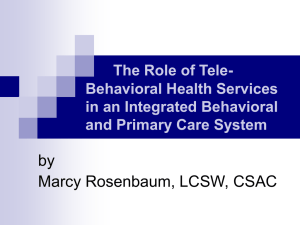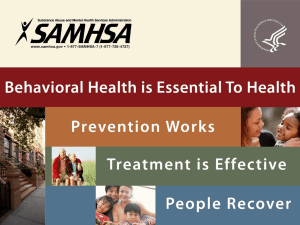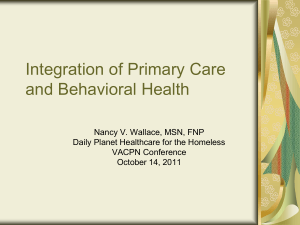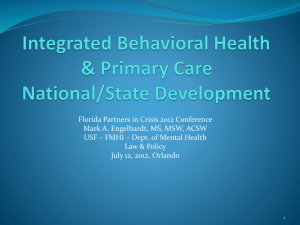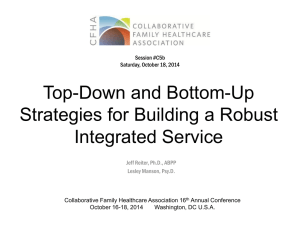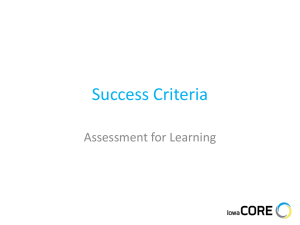H4a - Collaborative Family Healthcare Association
advertisement
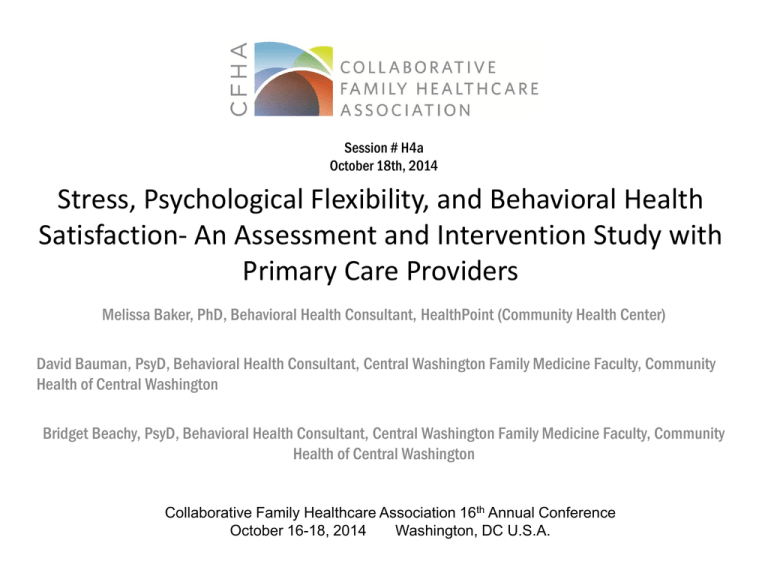
Session # H4a October 18th, 2014 Stress, Psychological Flexibility, and Behavioral Health Satisfaction- An Assessment and Intervention Study with Primary Care Providers Melissa Baker, PhD, Behavioral Health Consultant, HealthPoint (Community Health Center) David Bauman, PsyD, Behavioral Health Consultant, Central Washington Family Medicine Faculty, Community Health of Central Washington Bridget Beachy, PsyD, Behavioral Health Consultant, Central Washington Family Medicine Faculty, Community Health of Central Washington Collaborative Family Healthcare Association 16th Annual Conference October 16-18, 2014 Washington, DC U.S.A. Faculty Disclosure • We have not had any relevant financial relationships during the past 12 months. Learning Objectives At the conclusion of this session, the participant will be able to: 1. Identify methods for measuring PCP work-stress, psychological flexibility, and perceptions of behavioral health services a) Understand the relationship between PCP work-stress and psychological flexibility 2. Understand how to apply the Trident Approach to research in primary care 3. Learn a new approach or strategy for promoting increased teamwork, integration and BH services Bibliography / Reference Gray, B. H., Stockley, K., & Zuckerman, S. (2012). American primary care physicians' decisions to leave their practice: Evidence from the 2009 commonwealth fund survey of primary care doctors. Journal of Primary Care & Community Health. doi:10.1177/2150131911425392 Heath, B., Wise Romero, P., & Reynolds, k. (2013). A Standard Framework for Levels of Integrated Healthcare. SAMHSAHRSA Center for Integrated Health Solutions, 1-13. Retrieved May 11, 2014, from http://www.integration.samhsa.gov/integrated-caremodels/A_Standard_Framework_for_Levels_of_Integrated_Healthcare.pdf Levey, S. B., Miller, B. F., & deGruy III, F. V. (2012). Behavioral health integration: an essential element of populationbased healthcare redesign. Translational Behavioral Medicine, 2(3), 364-371. doi:10.1007/s13142-012-0152-5 Robinson, P. J., Gould, D., & Strosahl, K. D. (2011). Real Behavior Change in Primary Care. Strategies and Tools for Improving Outcomes and Increasing Job Satisfaction. Oakland: New Harbinger Robinson, P. J. & Reiter, J. T. (2014). Behavioral Consultation and Primary Care: A Guide to Integrating Services, 2 nd Edition. NY: Springer. Robinson, P. & Strosahl, K. (2009). The Primary Care Behavioral Health model: Lessons learned. Journal of Clinical Psychology in Medical Settings,16, 58-71. Substance Abuse and Mental Health Services Administration (SAMHSA, 2014). Integrated care models. In SAMHSAHRSA Center for Integrated Health Solutions. Retrieved August 30, 2014, from http://www.integration.samhsa.gov/integrated-care-models Learning Assessment • A learning assessment is required for CE credit. • A question and answer period will be conducted at the end of this presentation. Who we are… *Started BH program in 2000 *9 BHCs, 6 Pre-doctoral interns in 11 clinics *FQHC Integrated Behavioral Health Program Integration, you say? Shared practice space Billing Practice Change Clinical: Tx plan; Shared EBPs (5th & 6th) Organization support Care team: One stop shop (Health, Wise Romero, & Reynolds, 2013) “Trident” Approach to Integrated Care Research #1 Clinical Interventions #2 Train/Educate providers for caring for “whole person” #3 Assist/ Support PCPs Why do this study? • Impact of ACA – Only 40% of US physicians are PCPs • Of younger PCPs, 30% plan to leave PC within 5 years • Of older PCPs, 27% plan to retire AND 25% to leave PC within 5 years • Psychological flexibility related to work-stress • Focus on integration – Ranges of integration; what works best? – Lessons have been learned over the years… (Gray, Stockley & Zuckerman, 2012; Health et al., 2013; Levey, Miller & deGruy III, 2012; SAMHSA, 2014; Robinson, Gould & Strosahl, 2011; Robinson & Strosahl, 2010) Overview of Study • Phase 1 (Online survey to medical providers) – Primary Care Provider Stress Checklist (PCP-SC) – Primary Care Provider Acceptance and Action Questionnaire (PCP-AAQ) – AAQ-II – Primary Care Provider Satisfaction Form (O’Donahue) • Phase 2 – 4 BHC’s paired with a total of 7 medical providers (MD, DO, NP) Provider Demographics • 57 providers (50 completed entire survey) – Majority (N = 37) MDs – Majority early in their careers • • • • 0 – 5 years = 22 6 – 10 = 11 11 – 15 = 10 16+ = 13 Phase 1 Results • Increases in flexibility, stress levels decrease • PCP-SC (p < .01; r = -.52) with PCP-AAQ • Increase in flexibility, stress levels decrease • PCP-SC (p < .01; r = .60) with AAQ - II • Providers’ satisfaction with BH increases, their stress decreases * • PCP-SC (p < .01; r = -.40) with BH satisfaction survey • PCP-AAQ accounted for 27% of the variance (p < .000) • Control for degree type (i.e., MD, DO, NP), the variance is 30% Specific BH satisfaction results • 100% satisfied with BH – 34 = Strongly Agree (68%); 16 – Somewhat Agree (32%) • 100% recommend having BH services – 47 = Strongly Agree (94%); 3 = Somewhat Agree (6%) • 100% believe referral process easier – 48 = Strongly Agree (96%); 2 = Somewhat Agree (4%) • 84% agree patients more compliant – 17 = Strongly Agree (34%); 25 = Somewhat Agree (50%) • 100% agree having BH makes job easier – 45 = Strongly Agree (90%); 5 = Somewhat Agree (10%) • Write in responses*** Implications • Supports #3 Trident approach • Psychological flexibility & stress – How to improve flexibility? • Within every day practice? • Formal training? • Need psychometrics on measures • BH satisfaction implications Phase 2 of study • Pairing BHC w/ PCPs for one week – Incorporate some of the BH survey feedback • Strive to see every patient • Before, during, after • Goals: – Expand scope of BH services – Decrease stigma of BH – Increase collaboration and teamwork – …evaluate new strategy to integrated care Phase 2 Results • Saw more patients!!! – Total of 211 patients (M = 52.75, SD = 5.25) • 2.61 patients per hour (SD = .51) • 65% first time visits* – Patient breakdown • • • • • • <18 y/o = 39 18-64 = 159 65+ = 14 English speaking: 144 Spanish speaking: 46 Other: 21 Top BH Diagnoses for the Week Top BH diagnoses prior to intervention week Top BH diagnoses during intervention week 1. Depression 1 Counseling NOS 2. Anxiety 2. Stress 3. Counseling NOS 3. Depression 4. Parenting related 4. Diabetes Mellitus 5. Stress 5. Anxiety 6t. Chronic Pain 6. Hypertension 6t. Sleep 7. Obesity 8. Obesity 8. Tobacco 9t. Mood NOS 9. Parenting related 9t. Alcohol 10. Chronic Pain Qualitative Results • Medical assistants themes 1. 2. 3. 4. Improve workflow Destigmatizing behavioral health services Promoting behavioral health services Improve efficiency • PCP themes 1. Streamline workflow 2. New utilization of BH 3. Improve efficiency Our experiences Implications • Evolution of the PCBH model at HealthPoint – Closed model schedule – Bothell clinic • • • • Nurse schedule model 4 x 4 hour shifts of only warm handoffs/in-clinic patients One full day a week of scheduled visits, still w/ warm handoff slots built in Observations: Good and bad • Training model? – For PCPs, MAs and BHs • Hitting the “mark” of level 5 and 6 • Addressing many issues of integration Limitations • HealthPoint FREE BHC services – Easier to do co-visits with multiple providers – Brief visits (15 minutes or less) are possible – No concerns about cost (patient refusal low) • Only 1 or 2 providers per clinic – Fair? • Do not have the “people power” Rationale using “Trident Approach” • PHASE 1 – Assess aspects of PCP stress (#3, Assist/Support PCPs) – Program evaluation • Phase 2 – Fulfill consulting role for increased PCP satisfaction (#3) – Provide direct clinical interventions (#1, Clinical Interventions) • Provide appropriate better/more informed patient care (#1) • Increased patient satisfaction, wait time (#3) – Promotion of whole person care (#2, Train/Educate providers for caring for “whole person”) • BOTTOM LINE – IMPROVE INTEGRATION to become STANDARD CARE Questions? Session Evaluation Please complete and return the evaluation form to the classroom monitor before leaving this session. Thank you!

